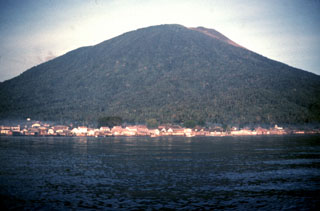Report on Gamalama (Indonesia) — 29 July-4 August 2015
Smithsonian Institution / US Geological Survey
Weekly Volcanic Activity Report, 29 July-4 August 2015
Managing Editor: Sally Sennert.
Please cite this report as:
Global Volcanism Program, 2015. Report on Gamalama (Indonesia) (Sennert, S, ed.). Weekly Volcanic Activity Report, 29 July-4 August 2015. Smithsonian Institution and US Geological Survey.
Gamalama
Indonesia
0.81°N, 127.3322°E; summit elev. 1714 m
All times are local (unless otherwise noted)
On 4 August, BNPB reported that Gamalama continued to erupt, although with low intensity. Tremor was continuous. The Alert Level remained at 2 (on a scale of 1-4); visitors and residents were warned not to approach the crater within a radius of 1.5 km. The total number of evacuees in shelters was 1,791. Based on local observations, a SIGMET and wind data, and satellite images, the Darwin VAAC reported that an ash plume drifted over 20 km NW on 4 August.
Geological Summary. Gamalama is a near-conical stratovolcano that comprises the entire island of Ternate off the western coast of Halmahera, and is one of Indonesia's most active volcanoes. The island was a major regional center in the Portuguese and Dutch spice trade for several centuries, which contributed to the extensive documentation of activity. Three cones, progressively younger to the north, form the summit. Several maars and vents define a rift zone, parallel to the Halmahera island arc, that cuts the volcano; the S-flank Ngade maar formed after about 14,500–13,000 cal. BP (Faral et al., 2022). Eruptions, recorded frequently since the 16th century, typically originated from the summit craters, although flank eruptions have occurred in 1763, 1770, 1775, and 1962-63.
Sources: Badan Nacional Penanggulangan Bencana (BNPB), Darwin Volcanic Ash Advisory Centre (VAAC)

